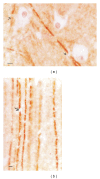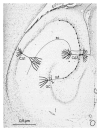Cognitive deterioration and associated pathology induced by chronic low-level aluminum ingestion in a translational rat model provides an explanation of Alzheimer's disease, tests for susceptibility and avenues for treatment
- PMID: 22928148
- PMCID: PMC3423924
- DOI: 10.1155/2012/914947
Cognitive deterioration and associated pathology induced by chronic low-level aluminum ingestion in a translational rat model provides an explanation of Alzheimer's disease, tests for susceptibility and avenues for treatment
Abstract
A translational aging rat model for chronic aluminum (Al) neurotoxicity mimics human Al exposure by ingesting Al, throughout middle age and old age, in equivalent amounts to those ingested by Americans from their food, water, and Al additives. Most rats that consumed Al in an amount equivalent to the high end of the human total dietary Al range developed severe cognitive deterioration in old age. High-stage Al accumulation occurred in the entorhinal cortical cells of origin for the perforant pathway and hippocampal CA1 cells, resulting in microtubule depletion and dendritic dieback. Analogous pathological change in humans leads to destruction of the perforant pathway and Alzheimer's disease dementia. The hippocampus is thereby isolated from neocortical input and output normally mediated by the entorhinal cortex. Additional evidence is presented that Al is involved in the formation of neurofibrillary tangles, amyloid plaques, granulovacuolar degeneration, and other pathological changes of Alzheimer's disease (AD). The shared characteristics indicate that AD is a human form of chronic Al neurotoxicity. This translational animal model provides fresh strategies for the prevention, diagnosis, and treatment of AD.
Figures








Similar articles
-
An aluminum-based rat model for Alzheimer's disease exhibits oxidative damage, inhibition of PP2A activity, hyperphosphorylated tau, and granulovacuolar degeneration.J Inorg Biochem. 2007 Sep;101(9):1275-84. doi: 10.1016/j.jinorgbio.2007.06.001. Epub 2007 Jun 12. J Inorg Biochem. 2007. PMID: 17662457
-
Deficits in synaptic function occur at medial perforant path-dentate granule cell synapses prior to Schaffer collateral-CA1 pyramidal cell synapses in the novel TgF344-Alzheimer's Disease Rat Model.Neurobiol Dis. 2018 Feb;110:166-179. doi: 10.1016/j.nbd.2017.11.014. Epub 2017 Dec 1. Neurobiol Dis. 2018. PMID: 29199135 Free PMC article.
-
Alzheimer's disease.Subcell Biochem. 2012;65:329-52. doi: 10.1007/978-94-007-5416-4_14. Subcell Biochem. 2012. PMID: 23225010 Review.
-
Can the controversy of the role of aluminum in Alzheimer's disease be resolved? What are the suggested approaches to this controversy and methodological issues to be considered?J Toxicol Environ Health. 1996 Aug 30;48(6):615-35. doi: 10.1080/009841096161104. J Toxicol Environ Health. 1996. PMID: 8772802 Review.
-
Hippocampal formation: anatomy and the patterns of pathology in Alzheimer's disease.Prog Brain Res. 1990;83:445-57. doi: 10.1016/s0079-6123(08)61268-6. Prog Brain Res. 1990. PMID: 2392569
Cited by
-
Understanding Aspects of Aluminum Exposure in Alzheimer's Disease Development.Brain Pathol. 2016 Mar;26(2):139-54. doi: 10.1111/bpa.12333. Epub 2015 Dec 8. Brain Pathol. 2016. PMID: 26494454 Free PMC article. Review.
-
Systematic review of potential health risks posed by pharmaceutical, occupational and consumer exposures to metallic and nanoscale aluminum, aluminum oxides, aluminum hydroxide and its soluble salts.Crit Rev Toxicol. 2014 Oct;44 Suppl 4(Suppl 4):1-80. doi: 10.3109/10408444.2014.934439. Crit Rev Toxicol. 2014. PMID: 25233067 Free PMC article.
-
Iron Dyshomeostasis Participated in Rat Hippocampus Toxicity Caused by Aluminum Chloride.Biol Trace Elem Res. 2020 Oct;197(2):580-590. doi: 10.1007/s12011-019-02008-7. Epub 2019 Dec 17. Biol Trace Elem Res. 2020. PMID: 31848921
-
Effects of aluminium on β-amyloid (1-42) and secretases (APP-cleaving enzymes) in rat brain.Neurochem Res. 2014 Jul;39(7):1338-45. doi: 10.1007/s11064-014-1317-z. Epub 2014 May 3. Neurochem Res. 2014. PMID: 24792732
-
Neuroprotective Effects of Higenamine Against the Alzheimer's Disease Via Amelioration of Cognitive Impairment, Aβ Burden, Apoptosis and Regulation of Akt/GSK3β Signaling Pathway.Dose Response. 2020 Dec 11;18(4):1559325820972205. doi: 10.1177/1559325820972205. eCollection 2020 Oct-Dec. Dose Response. 2020. PMID: 33354171 Free PMC article.
References
-
- Price M, Jackson J, editors. Alzheimer’s Disease International World Alzheimer Report 2009, http://www.alz.co.uk/research/files/World%20Alzheimer%20Report.pdf.
-
- Morris JC. Differential diagnosis of Alzheimer’s disease. Clinics in Geriatric Medicine. 1994;10(2):257–276. - PubMed
-
- Humphry GM. Old Age: The Results of Information Received Respecting Nearly Nine Hundred Persons Who Had Attained the Age of Eighty Years, Including Seventy-Four Centenarians. Cambridge, UK: MacMillan and Bowes; 1889.
-
- Henderson AS. The epidemiology of Alzheimer’s disease. British Medical Bulletin. 1986;42(1):3–10. - PubMed
-
- Blansjaar BA, Thomassen R, Van Schaick HW. Prevalence of dementia in centenarians. International Journal of Geriatric Psychiatry. 2000;15(3):219–225. - PubMed
LinkOut - more resources
Full Text Sources
Miscellaneous

